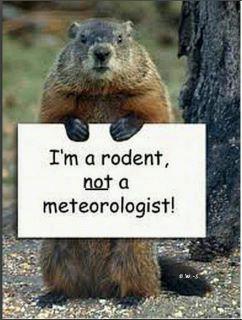It's Groundhog Day. Again.
Nearly every month of the year has its holidays – some of them to celebrate joyous religious occasions, others to commemorate historical figures or events. And then, some are just plain whimsical. Groundhog Day is celebrated on February 2, the almost-midpoint between the winter solstice and spring equinox. This point in the calendar year has been significant for centuries, as cultures anticipated the birth of farm animals and planting of crops. German immigrants to the United States carried with them a legend that badgers and bears emerged from hibernation to check the weather at this time. A sunny day had the animals seeing their shadow, indicating more winter. A cloudy day was a sign of milder weather and an early spring.
The centuries of cultural traditions led to a new event in 1887, thanks to an enterprising newspaper editor in a small German coal-mining town in Pennsylvania. That year on February 2 – now known as Groundhog Day - a groundhog named Punxsutawney Phil made his first appearance at a site known as Gobbler’s Knob. You know the formula, rooted in old tradition: Sunny day means a shadow and six more weeks of winter; a cloudy day means spring is just around the corner. Every year since that first publicity stunt, Phil is yanked from his burrow (actually, he’s housed in a pen for easy access) by local dignitaries and serves as a playful predictor of the weather. Not a very reliable predictor as he is right about 50% of the time, but it’s an excuse to break up the long winter. Interestingly, Groundhog Day weather predictions were censored during World War II. Weather conditions were considered a military secret. As one broadcaster of that era explained: “To broadcast that a groundhog does or does not see his shadow might reveal sky conditions to the enemy. Annual Groundhog Day predictions will have to be skipped.” And so, celebrations were kept quiet from 1939 till 1945 when the war ended. The U.S. tradition of Groundhog Day is immortalized in the 1993 movie about a grumpy weatherman (Bill Murray) who relives the holiday on repeat until he can get his act together.

Groundhogs are rodents, relatives to squirrels, prairie dogs and chipmunks. They are found in a range from eastern and central US, into Canada and Alaska. Adults weigh up to 13 pounds with a body length of 20 inches plus a short, bushy tail. They are solitary animals that live in extensive burrow systems and are mostly herbivores, feeding on a variety of grasses, forbs, fruits and tree bark. While they are usually seen on the ground, they are capable swimmers and can climb trees. They can be very destructive to gardens, as they feed voraciously to put on fat stores to sustain themselves throughout winter hibernation. In North Dakota, groundhogs are known as woodchucks and are relatively rare. North Dakota’s wildlife professionals explain that woodchucks are not a managed animal, so there are no surveys and there is no data on population numbers. There were requests for Game & Fish wardens in the Bottineau area to trap nuisance woodchucks, a few years back. Refuge managers report that woodchucks have not been seen in the Souris valley since the 2011 Minot flood. Perhaps the best evidence for their existence in the state is that the woodchuck is the mascot of St. John school in Rolette county, perched on the Canadian border. Certainly, there is no reason for a hibernating woodchuck to emerge from a cozy North Dakota burrow during the dead of winter. We’ll leave that up to Punxsutawney Phil.
This photo by Unknown Author is licensed under CC BY-SA

